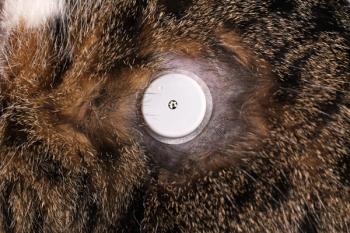
Rely on clinical skills to diagnose ferret adrenal disease
Medical treatment of adrenal disease is usually reserved for ferrets that are poor surgical candidates.
Signalment:
Mustelidae, Ferret, 7 years old, F/S, 1.5 lbs.
Clinical history:
The ferret presented for losing hair on the tail.
Physical examination:
The findings include rectal temperature 101°F, no heart murmur heard, pink mucous membranes, and nonsluggish capillary refill time at <1 second. The ferret is bright/alert/responsive, normal lymph nodes, normal abdomen, hair loss of tail, gingivitis and dental disease. There has been no therapy.
Editor's Note: In our ongoing telemedicine series, Dr. Johnny Hoskins presents medical case studies. The format is heavily focused on radiology and ultrasonography and details complicated, yet fairly common cases most veterinarians will be exposed to in practice.
Laboratory results:
A partial complete blood count and serum chemistry profile was performed and is outlined in Table 1. Urinalysis was not done. The fecal examination is negative for parasites.
Radiographic review:
Survey abdominal radiographs are done.
My comments:
The abdominal radiographs show enlarged spleen, soft tissue mass associated with left kidney and another soft tissue mass next to the right kidney.
Ultrasound examination:
Thorough abdominal ultrasonography is performed with the ferret positioned in dorsal recumbency.
My comments:
The liver shows an inhomogeneous texture in its parenchyma. No masses noted within the liver parenchyma. The gall bladder is mildly distended, and its walls are not thickened or hyperechoic. The gall bladder does contain a lot of sludge material. The spleen is prominent (sedated used for the study) and shows an inhomogeneous texture in its parenchyma - no masses noted. The left and right kidneys are similar in size, shape and echotexture. Each kidney shows an inhomogeneous texture in the renal cortex. A large cortical cyst is present in the caudal pole of the left kidney. No masses or calculi were noted in either kidney. The urinary bladder is distended with urine and contains some urine sediment material - no masses or calculi noted.
Image2
The stomach, small intestine and pancreas are normal. The pancreas shows a decreased mixed echogenicity in its parenchyma.
An irregular-shaped echogenic area with a single anechoic lesion is seen caudal to the liver and cranial to the right kidney. An echogenic irregular-shaped area with an anechoic lesion in its parenchyma is seen in the mid-abdomen cranial to the right kidney.
Another lesion of similar shape and echotexture is seen in the right cranial abdomen, caudoventral to the liver and dorsal to the spleen.
Image3
Case management:
In this case, adrenal tumors are the primary clinical differential diagnosis. At this point, an exploratory laparotomy would be warranted to possibly remove the neoplastic process, inspect the abdominal cavity for potential metastatic disease and collect appropriate biopsies for histopathologic examination. Therapy thereafter would depend on the findings from the exploratory laparotomy and histopathologic examination.
Image4
Review adrenal tumors:
Adrenal gland tumors are a common problem for ferrets 3 years and older, although this condition can occur at any age. The most common signs of an adrenal tumor are: hair loss or thinning on the body of the ferret (in advanced cases, hair may only remain on the head and feet and some have only their whiskers remaining); loss of muscle mass and a pot-bellied appearance; thin skin or almost translucent; itchiness; excessive water consumption; aggressive or mating behavior (mating behavior with inanimate objects, i.e., their blanket, stuffed toys, etc.); and an enlarged vulva.
Image5
In males, urination difficulties may be present due to enlarged prostatic tissue and this can become life-threatening if not treated.
Adrenal disease in ferrets is usually diagnosed by clinical signs. There are no definitive tests that can be performed that will reveal adrenal disease. Standard blood work will be normal assuming the ferret is healthy in every respect except for the adrenal problem.
There is currently only one hormonal panel that will confirm adrenal disease in the ferret, which is run by the University of Tennessee, School of Veterinary Medicine - this test is often referred to as "The Tennessee Panel." Radiography and ultrasonography may be useful at times in the diagnosis of adrenal disease. Diseased adrenal glands can frequently be normal in size and shape and, therefore, will appear normal in radiography and ultrasonography.
Image6
Clinical signs
If ferrets are exhibiting the clinical signs of adrenal disease, then money is better spent on going right into surgery rather than on expensive tests. Surgery is the most effective treatment for adrenal disease and involves the removal of the affected adrenal gland.
In most cases, and for reasons unknown, the left gland is most often affected. This is fortunate since removal of the left adrenal gland is relatively easy in comparison to the right adrenal gland. The right gland is often attached to the vena cava and removal can be difficult.
Image7
Medical treatment of adrenal disease is usually reserved for ferrets that are poor surgical candidates. They may be older ferrets or ferrets with other medical problems that would make surgery high risk. Some people will opt for medical treatment because of the cost of surgery. Drug treatment must be continued for the rest of the ferret's life and in the long run can cost more than surgical correction.
The drugs used most frequently and successfully for the treatment of adrenal disease are Lupron and Melatonin. Neither will cure the disease but only provide a relief of the signs. Gonadotropin release hormone (GnRH) is released by the hypothalamus in a pulsatile manner to stimulate the pituitary gland to release FSH and LH into the bloodstream. It is necessary for normal pituitary function that the hypothalamus release GnRH in brief discontinuous pulses rather than sustained continuous secretion. The pituitary gland can and will rapidly lose its responsiveness to GnRH if exposed for extended intervals of time - become desensitized.
Lupron (leuprolide acetate) is a synthetic version of GnRH. It is more stable than the natural hormone and, therefore, is degraded much more slowly within the body. This is the key to how Lupron works. Once in the bloodstream, Lupron acts at the pituitary gland just as natural GnRH does.
However, since Lupron is administered at a relatively high dosage and isn't degraded easily, the sustained presence of the drug actually causes the pituitary gland to desensitize and, thus, cease production of LH and FSH.
While some ferrets with adrenal disease do well on Lupron, some ferrets may be unresponsive. This scenario could arise if the adrenal gland has become diseased in a way such that the zona reticularis will produce androgens independent of any regulation by FSH and LH.
If this should occur, the adrenal gland would probably continue to hypersecrete androgens even after Lupron therapy has reduced levels of FSH and LH. Since some ferrets do respond well to Lupron, it is often worth trying if the ferret owner is uncomfortable with the idea of surgery as a first remedy.
Also, Lupron therapy is a life-long protocol: the ferret will require regular doses of Lupron to keep the malfunctioning adrenal gland under control. In the long run, this can be more expensive than surgery, which is presumably a one-time procedure.
Monthly injection of Lupron is given at a dosage of 100 mcg/kg in the muscle of the back leg and then increased to 200 mcg/kg if it is adrenal carcinoma or if the ferret does not respond after two injections. Also, one can use Lupron depot once every four months at 2-3 mg/kg every four to six months intramuscularly. The dosage of 2 mg/kg every four months is five times higher than the 100 mcg (0.1 mg)/kg once a month when compared on a monthly basis. Either way, Lupron is an expensive human product.
There are two other GnRH analogs: Zoladex and Synarel. Zoladex (goserelin acetate) is also a long-acting GnRH analog. It comes in a monthly version and a three-month version. The main problem with Zoladex is it comes packaged already in a syringe, so it would be very hard to divide into sterile dosages small enough for ferrets.
This is also an expensive human product. Synarel (nafarelin acetate) is a nasal solution that would have to be given nasally twice a day. It would be extremely hard to divide this into small enough dosages for ferrets and then give it twice a day nasally.
Melatonin is another product that should stop the stimulation to the adrenal glands. Melatonin is a natural hormone that is secreted by the pineal gland. Melatonin is involved in activating (in the spring) and terminating (in the fall) the ferret hypothalamic-pituitary-gonadal axis in response to the seasonal changes in the photoperiod (amount of daylight).
Melatonin inhibits GnRH release, decreases LH and FSH, and ultimately decreases the sex hormone concentrations. Most of the work with melatonin in ferrets was done with intact jills to bring them into heat or to take them out of heat.
The questions about melatonin are the amount to give, time to administer the tablet, and the long-term effects on the adrenal hormones.
A suggestive dose is 1 mg/kg given around eight to nine hours after sunrise. Melatonin tablets are cheap and available without a prescription at various stores. Also, it is important to change the photoperiod to resemble winter (i.e. nine hours of light with 15 hours of darkness per day).
"In a recent study, 0.5 mg oral suspension of melatonin was administered once daily to 10 ferrets with confirmed adrenocortical disease. Ferrets were examined every four months for a year. In addition to clinical signs, ultrasonographic measurement of the adrenal glands, sex hormone concentrations and prolactin levels were measured. Nine of the 10 ferrets had moderate to dramatic improvement in clinical signs including hair growth, reduction of vulva swelling or reduction of prostatic size. There was no significant change in the size of the adrenal glands. Hormone concentrations varied greatly between each ferret, but all had one or more sex hormone with elevated plasma concentrations. Mean values of estradiol, 17-hydroxy-progesterone and DHEAS decreased after four months of treatment but the concentrations at eight and 12 months were higher than at initial levels. Androstenedione gradually increased in every ferret at each four-month interval. Prolactin concentrations steadily decreased throughout the 12-month period. Ferrets with adrenocortical disease may benefit from treatment with melatonin. This may involve melatonin's effect on gonadotropin or prolactin secretion from the pituitary gland.
Tumor growth is not affected by administration of melatonin. Even if tumor growth is not affected by the administration of melatonin, there is improvement in the coat and quality of life for ferrets with adrenocortical disease."
Lysodren mainly destroys the cortisol producing cells of the adrenal glands; however, in ferrets cortisol is not the problem. It is the sex steroids (estrogen, 17-hydroxy-progesterone and testosterone) and the androgens (DHEAS and androstenedione) that are being over-secreted. This is why Lysodren does not work well in ferrets. Furthermore, lowering cortisol levels can cause serious hypoglycemia problems if the ferret also has an insulinoma.
Information for this column contributed by Michael Janke at mjank@miamiferret.org. For more information go to
Newsletter
From exam room tips to practice management insights, get trusted veterinary news delivered straight to your inbox—subscribe to dvm360.




